air conditioning Peugeot 508 2018 Owner's Manual
[x] Cancel search | Manufacturer: PEUGEOT, Model Year: 2018, Model line: 508, Model: Peugeot 508 2018Pages: 320, PDF Size: 10.09 MB
Page 4 of 320
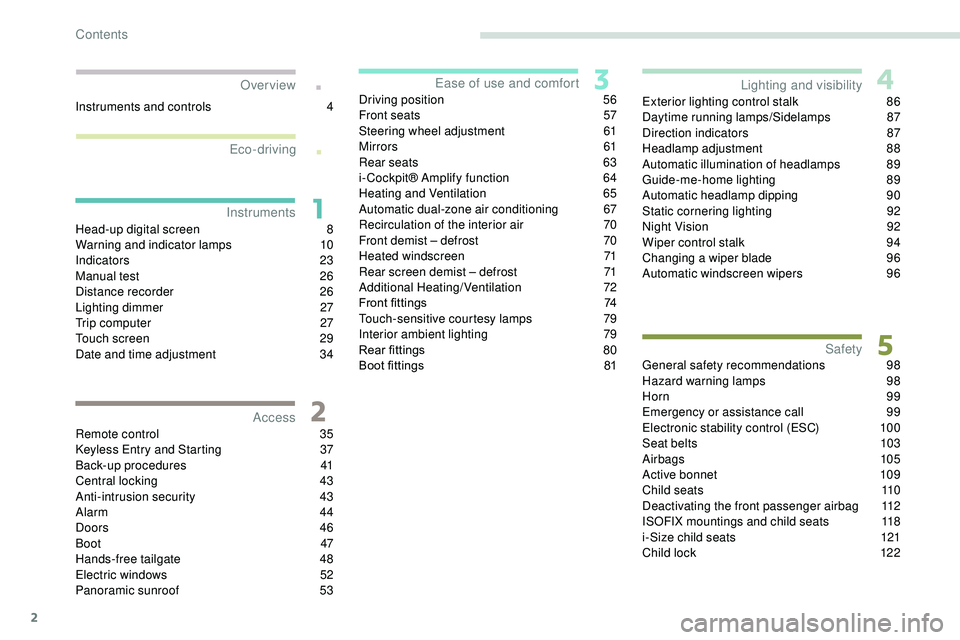
2
.
.
Head-up digital screen 8
W arning and indicator lamps 1 0
Indicators
23
Manual test
2
6
Distance recorder
2
6
Lighting dimmer
2
7
Trip computer
2
7
Touch screen
2
9
Date and time adjustment
3
4
Remote control
3
5
Keyless Entry and Starting
3
7
Back-up procedures
4
1
Central locking
43
A
nti-intrusion security
4
3
Alarm
44
Doors
4
6
Boot
47
Hands-free tailgate
4
8
Electric windows
5
2
Panoramic sunroof
5
3Driving position
5
6
Front seats
5
7
Steering wheel adjustment
6
1
Mirrors
61
Rear seats
6
3
i- Cockpit® Amplify function
6
4
Heating and Ventilation
6
5
Automatic dual-zone air conditioning
6
7
Recirculation of the interior air 7 0
Front demist – defrost 7 0
Heated windscreen
7
1
Rear screen demist – defrost
7
1
Additional Heating/Ventilation
7
2
Front fittings
7
4
Touch-sensitive courtesy lamps
7
9
Interior ambient lighting
7
9
Rear fittings
8
0
Boot fittings
8
1Exterior lighting control stalk
8
6
Daytime running lamps/Sidelamps
8
7
Direction indicators
87
H
eadlamp adjustment
8
8
Automatic illumination of headlamps
8
9
Guide-me-home lighting
8
9
Automatic headlamp dipping
9
0
Static cornering lighting
9
2
Night Vision 9 2
Wiper control stalk 9 4
Changing a wiper blade
9
6
Automatic windscreen wipers
9
6
General safety recommendations
9
8
Hazard warning lamps
9
8
Horn
9
9
Emergency or assistance call
9
9
Electronic stability control (ESC)
1
00
Seat belts
1
03
Airbags
105
Active bonnet
1
09
Child seats
1
10
Deactivating the front passenger airbag
1
12
ISOFIX mountings and child seats
1
18
i-Size child seats
1
21
Child lock
1
22
InstrumentsAccess
Over view
Ease of use and comfort
Lighting and visibility
Safety
Eco-driving
Instruments and controls 4
Contents
Page 7 of 320
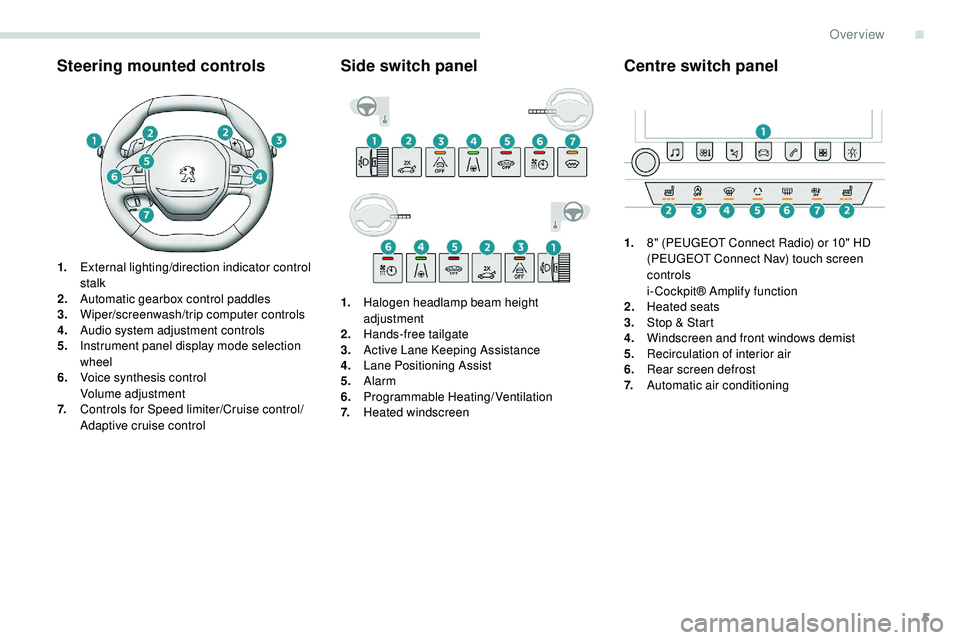
5
Steering mounted controls
1.External lighting/direction indicator control
stalk
2. Automatic gearbox control paddles
3. Wiper/screenwash/trip computer controls
4. Audio system adjustment controls
5. Instrument panel display mode selection
wheel
6. Voice synthesis control
Volume adjustment
7. Controls for Speed limiter/Cruise control/
Adaptive cruise control
Side switch panel
1.Halogen headlamp beam height
adjustment
2. Hands-free tailgate
3. Active Lane Keeping Assistance
4. Lane Positioning Assist
5. Alarm
6. Programmable Heating/Ventilation
7. Heated windscreen
Centre switch panel
1.8" (PEUGEOT Connect Radio) or 10" HD
(PEUGEOT Connect Nav) touch screen
controls
i- Cockpit® Amplify function
2. Heated seats
3. Stop & Start
4. Windscreen and front windows demist
5. Recirculation of interior air
6. Rear screen defrost
7. Automatic air conditioning
.
Over view
Page 8 of 320
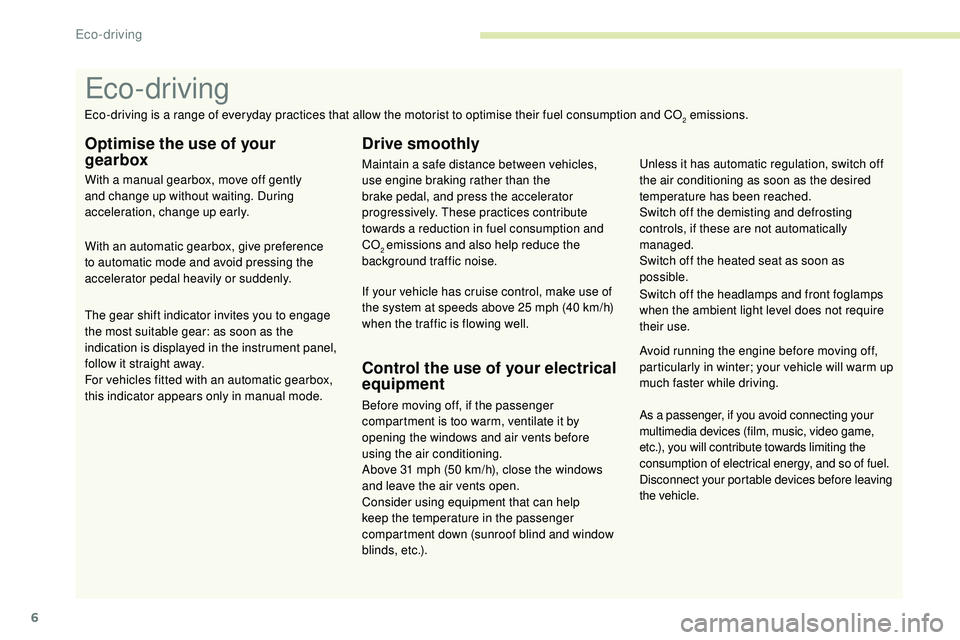
6
As a passenger, if you avoid connecting your
multimedia devices (film, music, video game,
etc.), you will contribute towards limiting the
consumption of electrical energy, and so of fuel.
Disconnect your portable devices before leaving
the vehicle.
Eco- driving
Optimise the use of your
gearbox
With a manual gearbox, move off gently
and change up without waiting. During
acceleration, change up early.
With an automatic gearbox, give preference
to automatic mode and avoid pressing the
accelerator pedal heavily or suddenly.
The gear shift indicator invites you to engage
the most suitable gear: as soon as the
indication is displayed in the instrument panel,
follow it straight away.
For vehicles fitted with an automatic gearbox,
this indicator appears only in manual mode.
Drive smoothly
Maintain a safe distance between vehicles,
use engine braking rather than the
brake pedal, and press the accelerator
progressively. These practices contribute
towards a reduction in fuel consumption and
CO
2 emissions and also help reduce the
background traffic noise.
If your vehicle has cruise control, make use of
the system at speeds above 25 mph (40 km/h)
when the traffic is flowing well.
Control the use of your electrical
equipment
Before moving off, if the passenger
compartment is too warm, ventilate it by
opening the windows and air vents before
using the air conditioning.
Above 31 mph (50 km/h), close the windows
and leave the air vents open.
Consider using equipment that can help
keep the temperature in the passenger
compartment down (sunroof blind and window
blinds, etc.). Switch off the headlamps and front foglamps
when the ambient light level does not require
their use.
Avoid running the engine before moving off,
particularly in winter; your vehicle will warm up
much faster while driving. Unless it has automatic regulation, switch off
the air conditioning as soon as the desired
temperature has been reached.
Switch off the demisting and defrosting
controls, if these are not automatically
managed.
Switch off the heated seat as soon as
possible.
Eco-driving is a range of everyday practices that allow the motorist to optimise their fuel consumption and CO
2 emissions.
Eco-driving
Page 31 of 320
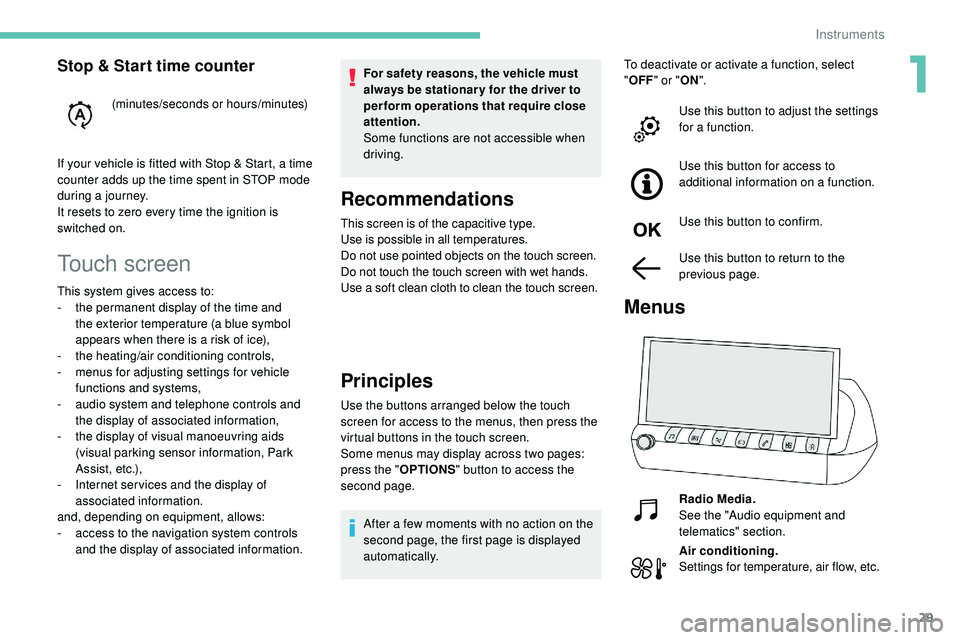
29
Touch screen
For safety reasons, the vehicle must
always be stationar y for the driver to
perform operations that require close
attention.
Some functions are not accessible when
driving.
Recommendations
This screen is of the capacitive type.
Use is possible in all temperatures.
Do not use pointed objects on the touch screen.
Do not touch the touch screen with wet hands.
Use a soft clean cloth to clean the touch screen.
Stop & Start time counter
(minutes/seconds or hours/minutes)
If your vehicle is fitted with Stop & Start, a time
counter adds up the time spent in STOP mode
during a journey.
It resets to zero every time the ignition is
switched on.
This system gives access to:
-
t
he permanent display of the time and
the exterior temperature (a blue symbol
appears when there is a risk of ice),
-
t
he heating/air conditioning controls,
-
m
enus for adjusting settings for vehicle
functions and systems,
-
a
udio system and telephone controls and
the display of associated information,
-
t
he display of visual manoeuvring aids
(visual parking sensor information, Park
A s s i s t , e t c .),
-
I
nternet ser vices and the display of
associated information.
and, depending on equipment, allows:
-
a
ccess to the navigation system controls
and the display of associated information.
Principles
Use the buttons arranged below the touch
screen for access to the menus, then press the
virtual buttons in the touch screen.
Some menus may display across two pages:
press the " OPTIONS" button to access the
second page.
After a few moments with no action on the
second page, the first page is displayed
automatically. To deactivate or activate a function, select
"
OFF " or " ON".
Use this button to adjust the settings
for a function.
Use this button for access to
additional information on a function.
Use this button to confirm.
Use this button to return to the
previous page.
Menus
Radio Media.
See the "Audio equipment and
telematics" section.
Air conditioning.
Settings for temperature, air flow, etc.
1
Instruments
Page 32 of 320

30
i-Cockpit® Amplify function.
Personalisation of the driving
ambience.or
You can also press with three fingers on
the touch screen to show all of the menu
buttons. Volume adjustment/mute.
See the "Audio equipment and
telematics" section.
Information banner(s)
Certain information is displayed permanently in
the side or upper banner(s) of the touch screen
(depending on version).
Connected navigation
.
See the "Audio equipment and
telematics" section.
Driving or Vehicle. *
Activation, deactivation and settings
of certain functions.
Telephone.
See the "Audio equipment and
telematics" section.
Applications.
Direct access to certain equipment
of the i- Cockpit® Amplify function.
For more information on Automatic dual-zone
air conditioning
, refer to the corresponding
section.
The functions accessible from this menu are
arranged on two tabs: " Driving functions" and
" Vehicle settings ".
For the other functions, refer to the "Audio
equipment and telematics" section. Settings.
Main settings for the audio system,
touch screen and digital instrument
panel.
For more information on the i-Cockpit®
Amplify function
, refer to the corresponding
section.
Top banner of the 8" touch screen
- Time and exterior temperature (a blue warning lamp appears when there is a risk
of i c e).
-
R
eminder of the air conditioning information,
and direct access to the shortcut menu.
Side banners of the 10" HD touch
screen
Left-hand side
- E xterior temperature (a blue warning lamp
appears when there is a risk of ice).
-
A
ccess to the Settings of the touch screen
and digital instrument panel (date/time,
languages, units, etc.).
-
R
eminder of the air conditioning information,
and direct access to the shortcut menu.
Right-hand side
-
Time.
-
Notifications.
-
R
eminder of the air conditioning information,
and direct access to the shortcut menu.
-
R
eminder of the Radio Media
and
Telephone menu information.
-
Notifications.
-
A
ccess to the Settings
of the touch screen
and digital instrument panel (date/time,
languages, units, etc.).
*
D
epending on equipment.
Instruments
Page 61 of 320
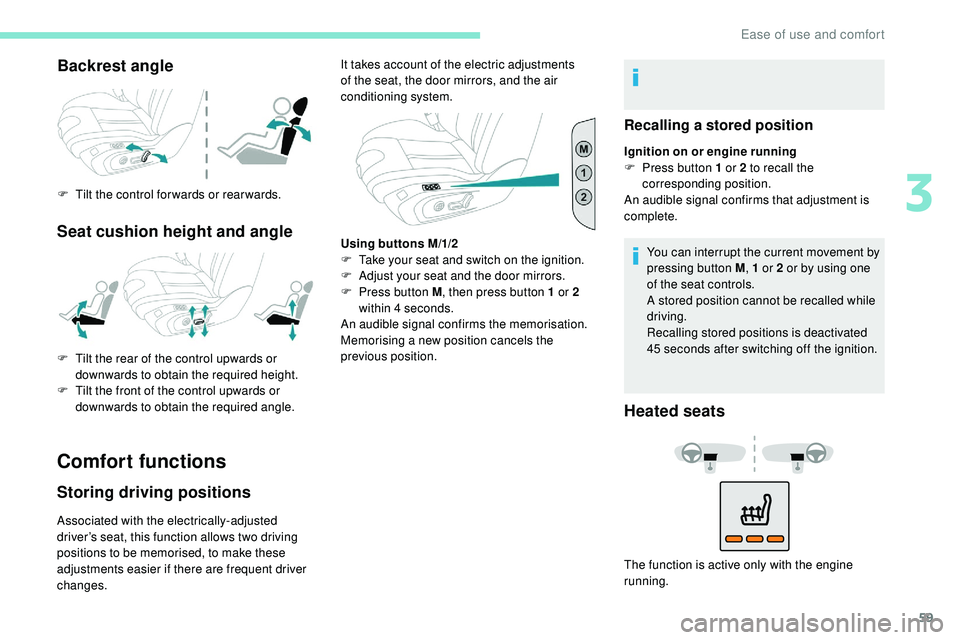
59
Backrest angle
F Tilt the control for wards or rear wards.
Seat cushion height and angle
Comfort functions
Storing driving positions
Associated with the electrically-adjusted
driver’s seat, this function allows two driving
positions to be memorised, to make these
adjustments easier if there are frequent driver
changes.It takes account of the electric adjustments
of the seat, the door mirrors, and the air
conditioning system.
F
T
ilt the rear of the control upwards or
downwards to obtain the required height.
F
T
ilt the front of the control upwards or
downwards to obtain the required angle.
Recalling a stored position
Ignition on or engine running
F P ress button 1 or 2 to recall the
corresponding position.
An audible signal confirms that adjustment is
complete.
You can interrupt the current movement by
pressing button M , 1 or 2 or by using one
of the seat controls.
A stored position cannot be recalled while
driving.
Recalling stored positions is deactivated
45 seconds after switching off the ignition.
Heated seats
The function is active only with the engine
running.
Using buttons M/1/2
F
T
ake your seat and switch on the ignition.
F
A
djust your seat and the door mirrors.
F
P
ress button M
, then press button 1 or 2
within 4 seconds.
An audible signal confirms the memorisation.
Memorising a new position cancels the
previous position.
3
Ease of use and comfort
Page 67 of 320
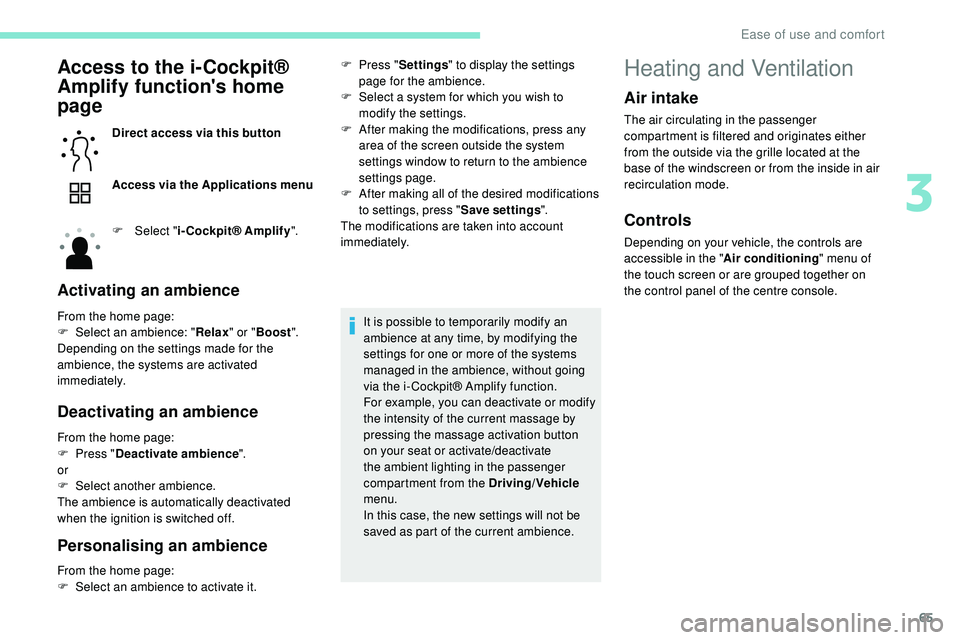
65
Access to the i-Cockpit®
Amplify function's home
page
Direct access via this button
Access via the Applications menu
F
Sel
ect "i-Cockpit® Amplify ".
Activating an ambience
From the home page:
F
Sel ect an ambience: " Relax" or "Boost ".
Depending on the settings made for the
ambience, the systems are activated
immediately.
Deactivating an ambience
From the home page:
F P ress " Deactivate ambience ".
or
F
Sel
ect another ambience.
The ambience is automatically deactivated
when the ignition is switched off.
Personalising an ambience
From the home page:
F S elect an ambience to activate it. It is possible to temporarily modify an
ambience at any time, by modifying the
settings for one or more of the systems
managed in the ambience, without going
via the i- Cockpit® Amplify function.
For example, you can deactivate or modify
the intensity of the current massage by
pressing the massage activation button
on your seat or activate/deactivate
the ambient lighting in the passenger
compartment from the Driving/Vehicle
menu.
In this case, the new settings will not be
saved as part of the current ambience.
F
P
ress "
Settings " to display the settings
page for the ambience.
F
S
elect a system for which you wish to
modify the settings.
F
A
fter making the modifications, press any
area of the screen outside the system
settings window to return to the ambience
settings page.
F
A
fter making all of the desired modifications
to settings, press " Save settings".
The modifications are taken into account
immediately.
Heating and Ventilation
Air intake
The air circulating in the passenger
compartment is filtered and originates either
from the outside via the grille located at the
base of the windscreen or from the inside in air
recirculation mode.
Controls
Depending on your vehicle, the controls are
accessible in the " Air conditioning" menu of
the touch screen or are grouped together on
the control panel of the centre console.
3
Ease of use and comfort
Page 68 of 320
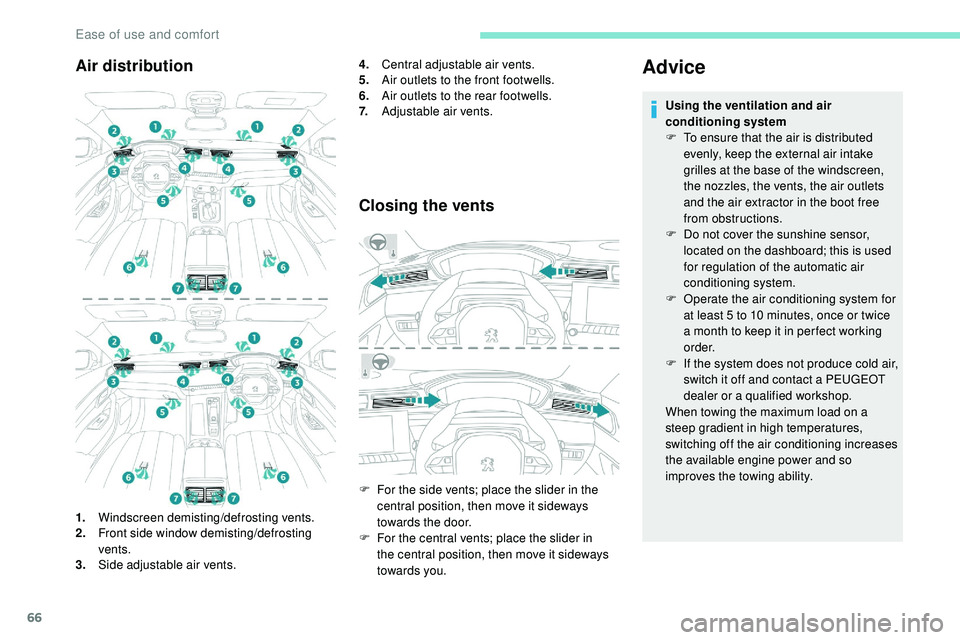
66
Air distribution
1.Windscreen demisting/defrosting vents.
2. Front side window demisting/defrosting
vents.
3. Side adjustable air vents. 4.
Central adjustable air vents.
5. Air outlets to the front footwells.
6. Air outlets to the rear footwells.
7. Adjustable air vents.
Advice
Using the ventilation and air
conditioning system
F
T
o ensure that the air is distributed
evenly, keep the external air intake
grilles at the base of the windscreen,
the nozzles, the vents, the air outlets
and the air extractor in the boot free
from obstructions.
F
D
o not cover the sunshine sensor,
located on the dashboard; this is used
for regulation of the automatic air
conditioning system.
F
O
perate the air conditioning system for
at least 5 to 10 minutes, once or twice
a month to keep it in per fect working
o r d e r.
F
I
f the system does not produce cold air,
switch it off and contact a PEUGEOT
dealer or a qualified workshop.
When towing the maximum load on a
steep gradient in high temperatures,
switching off the air conditioning increases
the available engine power and so
improves the towing ability.
F
F
or the side vents; place the slider in the
central position, then move it sideways
towards the door.
F
F
or the central vents; place the slider in
the central position, then move it sideways
towards you.
Closing the vents
Ease of use and comfort
Page 69 of 320
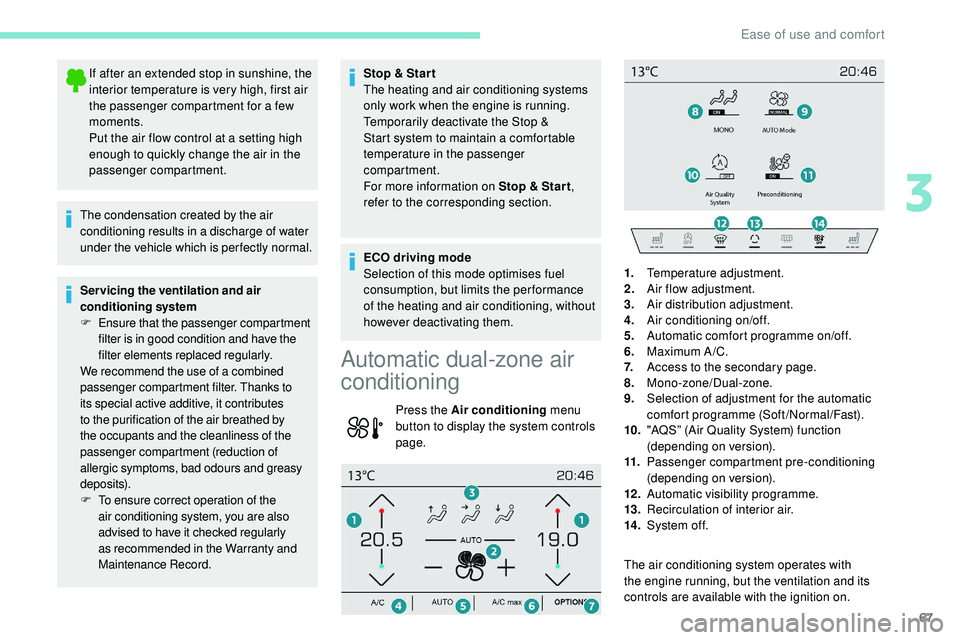
67
If after an extended stop in sunshine, the
interior temperature is very high, first air
the passenger compartment for a few
moments.
Put the air flow control at a setting high
enough to quickly change the air in the
passenger compartment.
The condensation created by the air
conditioning results in a discharge of water
under the vehicle which is per fectly normal.
Servicing the ventilation and air
conditioning system
F
E
nsure that the passenger compartment
filter is in good condition and have the
filter elements replaced regularly.
We recommend the use of a combined
passenger compartment filter. Thanks to
its special active additive, it contributes
to the purification of the air breathed by
the occupants and the cleanliness of the
passenger compartment (reduction of
allergic symptoms, bad odours and greasy
deposits).
F
T
o ensure correct operation of the
air conditioning system, you are also
advised to have it checked regularly
as recommended in the Warranty and
Maintenance Record. Stop & Star t
The heating and air conditioning systems
only work when the engine is running.
Temporarily deactivate the Stop &
Start system to maintain a comfortable
temperature in the passenger
compartment.
For more information on Stop & Star t
,
refer to the corresponding section.
ECO driving mode
Selection of this mode optimises fuel
consumption, but limits the performance
of the heating and air conditioning, without
however deactivating them.
Automatic dual-zone air
conditioning
Press the Air conditioning menu
button to display the system controls
page.
The air conditioning system operates with
the engine running, but the ventilation and its
controls are available with the ignition on.1.
Temperature adjustment.
2. Air flow adjustment.
3. Air distribution adjustment.
4. Air conditioning on/off.
5. Automatic comfort programme on/off.
6. Maximum A /C.
7. Access to the secondary page.
8. Mono-zone/Dual-zone.
9. Selection of adjustment for the automatic
comfort programme (Soft/Normal/Fast).
10. "AQS” (Air Quality System) function
(depending on version).
11. Passenger compartment pre-conditioning
(depending on version).
12 . Automatic visibility programme.
13. Recirculation of interior air.
14 . System of f.
3
Ease of use and comfort
Page 70 of 320
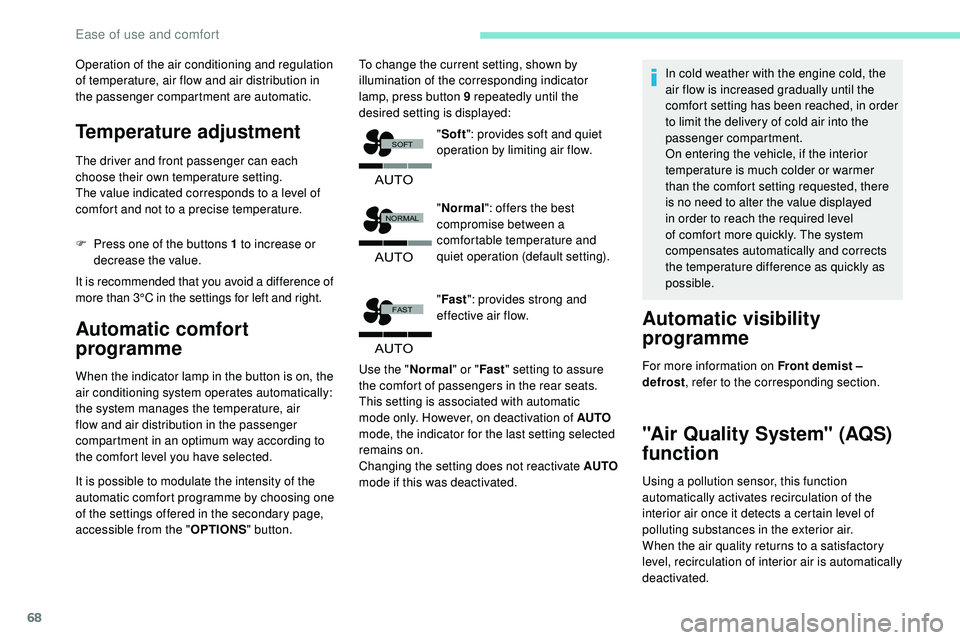
68
�$�8�7�2
�)�$�6�7
�$�8�7�2
�1�2�5�0�$�/
�6�2�)�7
�$�8�7�2
Operation of the air conditioning and regulation
of temperature, air flow and air distribution in
the passenger compartment are automatic.
Temperature adjustment
The driver and front passenger can each
choose their own temperature setting.
The value indicated corresponds to a level of
comfort and not to a precise temperature.
F
P
ress one of the buttons 1 to increase or
decrease the value.
It is recommended that you avoid a difference of
more than 3°C in the settings for left and right.
Automatic comfort
programme
When the indicator lamp in the button is on, the
air conditioning system operates automatically:
the system manages the temperature, air
flow and air distribution in the passenger
compartment in an optimum way according to
the comfort level you have selected.
It is possible to modulate the intensity of the
automatic comfort programme by choosing one
of the settings offered in the secondary page,
accessible from the " OPTIONS" button. To change the current setting, shown by
illumination of the corresponding indicator
lamp, press button 9 repeatedly until the
desired setting is displayed:
"Normal ": offers the best
compromise between a
comfortable temperature and
quiet operation (default setting).
" Fast ": provides strong and
effective air flow.
Use the " Normal" or "Fast" setting to assure
the comfort of passengers in the rear seats.
This setting is associated with automatic
mode only. However, on deactivation of AUTO
mode, the indicator for the last setting selected
remains on.
Changing the setting does not reactivate AUTO
mode if this was deactivated. In cold weather with the engine cold, the
air flow is increased gradually until the
comfort setting has been reached, in order
to limit the delivery of cold air into the
passenger compartment.
On entering the vehicle, if the interior
temperature is much colder or warmer
than the comfort setting requested, there
is no need to alter the value displayed
in order to reach the required level
of comfort more quickly. The system
compensates automatically and corrects
the temperature difference as quickly as
possible.
Automatic visibility
programme
For more information on Front demist –
defrost
, refer to the corresponding section.
"Air Quality System" (AQS)
function
Using a pollution sensor, this function
automatically activates recirculation of the
interior air once it detects a certain level of
polluting substances in the exterior air.
When the air quality returns to a satisfactory
level, recirculation of interior air is automatically
deactivated.
"
Soft ": provides soft and quiet
operation by limiting air flow.
Ease of use and comfort